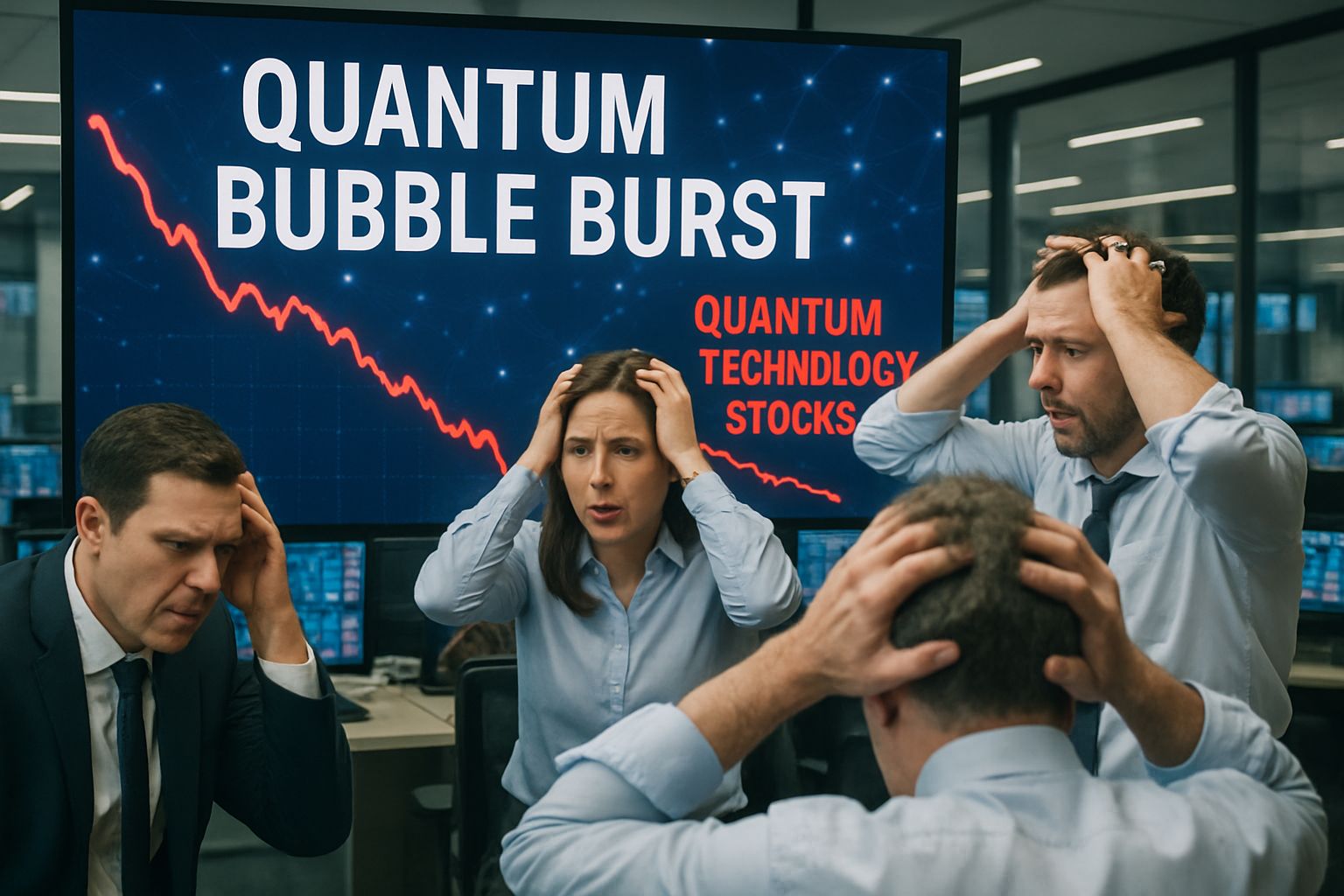
AI CERTS
1 day ago
Quantum bubble burst rattles fragile quantum stocks
This article unpacks the data, explores catalysts, and highlights forward indicators for professionals navigating the rapidly evolving quantum landscape.
Quantum Market Slide Explained
Sharp price moves rarely emerge from a single headline. Instead, several forces converged to produce the perceived quantum bubble burst. Firstly, both firms posted impressive revenue growth yet recorded eye-watering GAAP losses. Secondly, major equity raises flooded markets with new shares. Furthermore, Nvidia’s Jensen Huang cautioned that broadly useful quantum computers may be decades away. In contrast, D-Wave’s leadership insisted near-term annealing applications already generate cash. Nevertheless, the combination of long timelines and dilution rattled holders.

These overlapping factors triggered anxiety around speculative positioning unwind and broader hype cycle correction. Consequently, traders rushed to reduce exposure.
This section shows the selloff’s complexity. However, deeper valuation issues surface next.
Key Drivers Of Selloff
Several quantifiable factors pressured valuations:
- IonQ Q3 revenue reached $39.9 M, yet GAAP losses exceeded $1.1 B.
- D-Wave’s quarter delivered $3.7 M revenue but relied on warrant proceeds for cash.
- Price-to-sales multiples still exceed 400× for IonQ and 600× for D-Wave.
- McKinsey projects quantum revenues of $28-72 B by 2035, underscoring present-day gaps.
Moreover, algorithmic qubit milestones, while impressive, remain technical footnotes for many investors. Meanwhile, the speculative positioning unwind gained speed after each earnings call. Additionally, warrant revaluations produced non-cash charges that expanded headline losses. Therefore, some analysts framed the episode as an overdue hype cycle correction rather than an existential threat.
These statistics expose the mismatch between growth stories and income statements. Consequently, attention shifts toward speculative mechanics.
Speculative Positioning Unwind Begins
During early 2025, momentum traders poured capital into quantum names. Consequently, options flows and leveraged exchange-traded products magnified every uptick. However, risk sentiment flipped after Huang’s January remarks. Subsequently, stop-loss triggers fired, forcing sales into thin liquidity. Market depth evaporated, and the quantum bubble burst narrative gained traction.
Furthermore, pre-merger SPAC warrants matured, enabling arbitrage desks to short shares against cheap warrants. This practice accelerated the speculative positioning unwind still visible today. In contrast, long-only funds trimmed stakes yet maintained core exposure, citing positive commercialization timeline progress for selected workloads.
The unwinding phase revealed structural fragilities. Nevertheless, valuation fundamentals deserve equal scrutiny.
Valuation Reality Check Emerges
Equity raises intensified funding concerns. For example, IonQ’s $2 B offering boosted cash reserves to $3.5 B but diluted holders. Additionally, D-Wave’s warrant redemptions inserted millions of shares, depressing price momentum. Consequently, market caps now hover near $20 B and $9 B respectively—levels some analysts deem unsustainable until revenues scale materially.
Moreover, discounted cash-flow models struggle under uncertain commercialization timeline assumptions. In contrast, bulls claim optionality around government procurement and cloud partnerships justifies premium multiples. Nevertheless, historical analogs in solar and 3D printing warn that valuation resets can persist even while technology advances.
This reassessment anchors the phrase quantum bubble burst in earnings math, not engineering despair. Next, the timeline debate intensifies.
Technology Versus Timelines Debate
Gate-model proponents target fault-tolerant machines within 15-30 years, aligning with Huang’s perspective. However, annealing advocates argue meaningful workloads already run today. Additionally, IBM, Google, and Microsoft continue publishing peer-reviewed milestones, pushing the commercialization timeline closer for selected verticals.
Furthermore, hybrid quantum-classical workflows on AWS Braket and Azure Quantum attract early enterprise pilots. Nevertheless, many pilots remain subsidized experiments rather than production deployments, feeding the ongoing hype cycle correction. Consequently, revenue visibility beyond 2027 remains cloudy.
This debate shapes investor sentiment around the quantum bubble burst. However, capital requirements cannot be ignored.
Funding And Dilution Risks
Quantum hardware demands cryogenic systems, fab access, and PhD-level talent. Therefore, cash burn rates exceed $50 M per quarter at several firms. Moreover, rising rates elevate equity costs, exacerbating funding concerns. Consequently, investors monitor at-the-market offerings, convertible notes, and grant pipelines.
Additionally, governments fund national labs, but procurement timelines often slip. In contrast, cloud credits from hyperscalers provide limited relief. Nevertheless, professionals can strengthen strategic planning skills through the AI+ Quantum Specialist™ certification, positioning themselves for anticipated talent gaps.
Capital structure clarity will influence whether the quantum bubble burst deepens or stabilizes. Upcoming catalysts offer guidance.
Outlook And Action Items
Several near-term signals deserve monitoring:
- Next IonQ and D-Wave earnings, focusing on bookings quality.
- SEC filings detailing warrant liabilities and dilution impact.
- Peer-reviewed benchmarks validating error-correction progress.
- Government contract announcements influencing the commercialization timeline.
- Macroeconomic shifts that could prolong the speculative positioning unwind.
Furthermore, cross-sector alliances may shorten adoption cycles, tempering the ongoing hype cycle correction. Nevertheless, cautious position sizing remains prudent while funding concerns linger.
This roadmap arms professionals with actionable checkpoints. Consequently, they can navigate volatility rather than fear another quantum bubble burst.
Overall, disciplined monitoring and upskilling foster resilient strategies. However, final reflections clarify the broader narrative.
Conclusion
The recent slide illustrates markets repricing risk, not dismissing quantum promise. Moreover, outsized GAAP losses, dilution, and uncertain paybacks fueled the perceived quantum bubble burst. Nevertheless, technical momentum continues, and early revenues keep rising. Consequently, informed professionals should track fundamental catalysts, refine valuation models, and pursue continuous learning. Consider enhancing expertise through the linked certification and stay prepared for the sector’s next inflection point.



